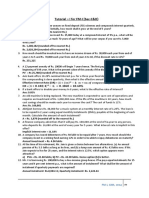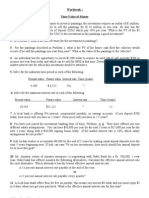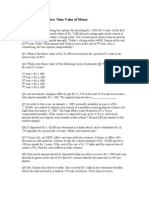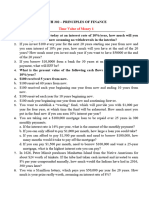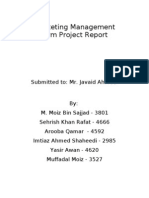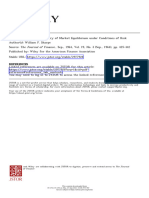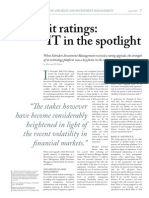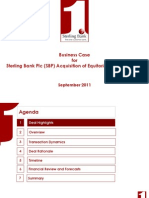Business Finance
Business Finance
Uploaded by
MAk KhanCopyright:
Available Formats
Business Finance
Business Finance
Uploaded by
MAk KhanOriginal Description:
Original Title
Copyright
Available Formats
Share this document
Did you find this document useful?
Is this content inappropriate?
Copyright:
Available Formats
Business Finance
Business Finance
Uploaded by
MAk KhanCopyright:
Available Formats
PROBLEMS CHAPTER 2 1) If you deposit Rs.
100 in the bank today and it earns interest at a rate of 8% compounded annually, how much will be in the account 50 years from today? 2) On your birthday, your uncle gave you the money in his savings account. His only deposit was Rs.100 made 50 years ago. The savings account paid 8% compounded annually. How much money is in the account today? 3) A loaf of bread costs Rs.0.79 today. If its price increases by 6% per year, how much will an equivalent loaf cost in 20 years? 4) You ask a friend with some interest factor tables for PVF.09,6. He tells you that the number on his table is 1.677, but the heading of the table is torn off, so he does not know if 1.677 is PVF.09,6 or FVF.09,6. Without looking at another table, can you tell which it is? Why? If it is FVF.09,6, what is PVF.09,6? 5) How much money must you deposit in a savings account today to have Rs.20,000 in 20 years if the interest rate is 8% compounded annually? 6) A stock has paid dividends regularly for the last 20 years, starting with Rs.0.75 in 1964 and rising to Rs.4 in 1984. If these dividends have been growing at a constant rate, what has that rate been for the last 20 years? 7) Your sister borrows Rs.1,000 and promises to repay Rs.2,000. If you want at least a 5% return on your loan, within how many years must she pay you back? 8) Which would you prefer: Rs.1,000 now, Rs.2,000 in 5 years, or Rs.3,000 in 10 years if your time value of money is 12%? 9) Which would you prefer: Rs.3,000 now, Rs.2,000 that was placed in a savings account 5 years ago, or Rs.1,000 that was placed in a savings account 10 years ago if (a) your time value of money is 12%. (b) your time value of money is 16%. (c) your time value of money is 8%. 10) Using a discount rate of 12%, find the present value of Rs.100 received at the end of each of the next four years (a) using only the PVF table. (b) using only the PVFA table.
11) Using a discount rate of 12%, find the future value as of the end of year 4 of Rs.100 received at the end of each of the next four years (a) using only the FVF table. (b) using only the FVFA table. (c) using only your answer to problem 10 and the fact that FVF.12,4 = 1.5735. 12) You ask a friend with some interest factor tables for PVFA.09,6 and she tells you that the number on her table is 7.5233, but the heading on the table is torn off, she does not know if 7.5233 is PVFA.09,6 or FVFA.09,6. Without looking at another table, can you tell which it is? Why? 13) How much must you save at the end of each of the next 10 years to have Rs.100,000 at the end of the 10th year if the interest rate is 10%? 14) If the discount rate is 12%, what is the present value of Rs.200 received at the end of each of the next 10 years except for the fourth year (i.e., you get payments at the end of years 1,2, 3, 5, 6, 7, 8, 9, and 10)? 15) If the discount rate is 14%, what is FV10 of Rs.300 received at the end of each of the next 10 years except for the fourth year? 16) What is the present value of a seven-year Rs.1,000 annuity if the first Rs.1,000 payment is made four years from today and the discount rate is 15%? 17) What is FV12 of a 10-year Rs.500 annuity for which the first Rs.500 payment is made at the end of the 3M year (and the 10th payment at the end of the 12th year) if the discount rate is 16%? 18) What is the present value of a 20-year annuity due with Rs.1,000 payments if the discount rate is 8%? [Hint: Assume that a payment made at the end of one year (as in an ordinary annuity) has the same present value as a payment made at the beginning of the next year (as in an annuity due). 19) What is FV10 of a 10-year annuity due with payments of Rs.1,000 if the discount rate is 10%? 20) How much must you deposit at the end of each year for 15 years to be able to withdraw Rs.500 at the end of 10 years and Rs.1,000 at the end of 15 years if your savings draw interest at an annual rate of 7%?
21) You are buying a Rs.100,000 home with a 30-year mortgage requiring payments to be made at the end of each year. The interest rate is 10% for the first 15 years of the mortgage but then increases to 15% for the last 15 years. How much will your annual payments be? 22) If you deposit Rs.100 in a savings account today, and keep it there for 50 years, how much would be in the account if the interest were 8% compounded semiannually? If it were 8% compounded quarterly? (Note: FVF.04,100 = 50.505 and FVF.02,200 = 52.485.) 23) A device is for sale that will save you 10% of your utility bill every year. Your time value of money is 12% and your utility bill is Rs.500 per year. Assuming that your utility bill remains constant and that you (and your heirs) will be around to enjoy the benefits of the device forever, how much should you be willing to pay for it? 24) You plan to retire in 40 years, at which time you want enough in a savings account to allow you to withdraw Rs.20,000 at the beginning of each of the subsequent 10 years (an insurance policy will support you if you live for more than 10 years after you retire). (a) If the savings account pays interest at an annual rate of 9%, how much must you have saved up by the end of the fortieth year? (b) If you deposit a fixed sum of money in the savings account at the end of each of the next 40 years to achieve the retirement goal of part (a), how much must you deposit each year? (c) Same as part (b), except that this time you only save for 20 years (at the end of each of years 21 through 40). 25) You are trying to decide whether to buy a Rs.2,500 motorcycle on credit or to save money to buy it in 30 months. If you buy on credit, you will make 30 equal end-of-the-month payments at a finance charge of 2% per month. If you save money to buy it in 30 months, you will earn 1% per month on your savings. However, the semiannual inflation rate is 5%, so the motorcycle will cost more in 2.5 years. (Suppose that you don't care when you take possession of the motorcycle; that is, you will make your decision solely on the basis of which plan has lower monthly requirements.) (a) What will your monthly payments be if you buy on credit? (b) What must your monthly deposits be if you choose to save money and buy it in 30 months? (c) What should you do?
26) Your brother has just graduated from high school and is seeking your advice as to whether he should find a job immediately or go to college for four years and then find a job. He estimates that if he gets a job immediately, he will earn Rs.15,000 per year for the next 40 years. If he goes to college first, he estimates that he can earn Rs.30,000 for each of the 36 years after he gets out. (Whether he goes to college or not, he plans to retire 40 years from today.) He also estimates that the four years of college will cost him Rs.8,000 each. Assume that his time value of money is 14% and that all cash flows are ordinary annuities. (If he goes to college first, he can borrow money at 14%, too.) (a) What will be the present value of his cash flows if he gets a job immediately? (b) What will be the present value of his cash flows if he goes to college first? (c) What should he do? 27) Consider an investment that pays Rs.80 in interest every year plus Rs.1,000 when it matures in 12 years. You can buy the investment today for Rs.753. What is the IRR of this investment? (Use a financial calculator for this problem.) 28) An automobile costs Rs.10,000 now, requires Rs.1,000 annually to maintain, and has a salvage value of Rs.2,000 at the end of eight years. Your time value of money is 9%. What is the NPV of these cash flows?
You might also like
- MTO Test PaperDocument3 pagesMTO Test PaperMAk Khan67% (3)
- Merck ReportsDocument40 pagesMerck ReportsMAk Khan100% (2)
- Sec - C - TVM 2019 - PW, FW, AW, GR, Nom-EffDocument4 pagesSec - C - TVM 2019 - PW, FW, AW, GR, Nom-EffNaveen Kumar0% (1)
- SAT Practice Test 2010-2011Document48 pagesSAT Practice Test 2010-2011Elvir CrncevicNo ratings yet
- Retirement PlanningDocument45 pagesRetirement PlanningPavan Kumar100% (1)
- HCGCCGFC SawaalDocument6 pagesHCGCCGFC SawaalBhanu SharmaNo ratings yet
- FINANCIAL MANAGEMENT Chapter 2Document37 pagesFINANCIAL MANAGEMENT Chapter 2JackNo ratings yet
- Assignment Problems of Financial Management PDFDocument39 pagesAssignment Problems of Financial Management PDFprashanth1911820% (2)
- TVM ProblemsDocument10 pagesTVM ProblemsVaibhav Jain0% (1)
- Time Value of Money Class ExerciseseDocument2 pagesTime Value of Money Class ExerciseseRohan JangidNo ratings yet
- SAPM Practice ProblemsDocument4 pagesSAPM Practice ProblemsMithun SagarNo ratings yet
- Economic NumericalDocument26 pagesEconomic NumericalSantosh ThapaNo ratings yet
- Exercises (Time Value of Money) : TH TH THDocument2 pagesExercises (Time Value of Money) : TH TH THbdiitNo ratings yet
- Practice Sheet 1Document2 pagesPractice Sheet 1ronakbhanushali59No ratings yet
- Corp Finance Hw1Document5 pagesCorp Finance Hw1Tran Tuan LinhNo ratings yet
- The Time Value MoneyDocument4 pagesThe Time Value Moneycamilafernanda85No ratings yet
- ImranOmer - 37 - 15663 - 4 - Time Value Money Practice Questions (Revised)Document3 pagesImranOmer - 37 - 15663 - 4 - Time Value Money Practice Questions (Revised)EmaanNo ratings yet
- Tutorial - I For FM-I: Effective Interest Rate (EIR)Document3 pagesTutorial - I For FM-I: Effective Interest Rate (EIR)Sriram VenkatakrishnanNo ratings yet
- TVM Ques N AnsDocument2 pagesTVM Ques N AnsPatitapaban ChoudhuryNo ratings yet
- Bai Tap Ham Tai ChinhDocument4 pagesBai Tap Ham Tai ChinhLoi NguyenNo ratings yet
- Fundamentals of Engineering Economic Analysis Assignment ExercisesDocument4 pagesFundamentals of Engineering Economic Analysis Assignment ExercisesdsadadadNo ratings yet
- WS-compound InterestDocument5 pagesWS-compound InterestSoma Roy BoraiNo ratings yet
- Ex. T.V.MDocument2 pagesEx. T.V.MGeethika NayanaprabhaNo ratings yet
- TVM PCDocument5 pagesTVM PCRashmi BendreNo ratings yet
- TVM Tutorial SolnDocument3 pagesTVM Tutorial SolnPoornika AwasthiNo ratings yet
- Illustrations TVM 2024-25Document4 pagesIllustrations TVM 2024-25forum.somaiya24No ratings yet
- TVM CWDocument4 pagesTVM CWDua hussainNo ratings yet
- TVM Question 55Document8 pagesTVM Question 55jaiNo ratings yet
- Assignment On Time Value of MoneyDocument2 pagesAssignment On Time Value of MoneyVijay NathaniNo ratings yet
- Tutorial - The Time Value of MoneyDocument6 pagesTutorial - The Time Value of MoneyFahmi CANo ratings yet
- Assignment 2 Course Name: Principles of FinanceDocument1 pageAssignment 2 Course Name: Principles of FinanceMohiuddin Al FarukNo ratings yet
- Time Value of Money ProblemsDocument2 pagesTime Value of Money ProblemsdaveferalNo ratings yet
- Time Value of Money - ProblemsDocument11 pagesTime Value of Money - ProblemsUbaid Dar100% (1)
- Fmi Assignment Time Value of ValueDocument8 pagesFmi Assignment Time Value of ValuerajeshNo ratings yet
- IRV Banikanta Mishra: Practice Assignment - 1Document9 pagesIRV Banikanta Mishra: Practice Assignment - 1SANCHITA PATINo ratings yet
- Practice Problem SetDocument3 pagesPractice Problem SetsadiqusNo ratings yet
- Assignment 1 PDFDocument2 pagesAssignment 1 PDFJeevan GonaNo ratings yet
- Homework QuestionsDocument6 pagesHomework Questionsgaurav shetty100% (1)
- FINC1302 - Exer&Asgnt - Revised 5 Feb 2020Document24 pagesFINC1302 - Exer&Asgnt - Revised 5 Feb 2020faqehaNo ratings yet
- Solve The Following Crossword Round Your Final Answers To TheDocument3 pagesSolve The Following Crossword Round Your Final Answers To TheAmit PandeyNo ratings yet
- Workbook1 TimevalueofMoneyDocument2 pagesWorkbook1 TimevalueofMoneyDe BuNo ratings yet
- 03a TVM QuestionsDocument2 pages03a TVM QuestionsSaad ZamanNo ratings yet
- TVM Questions IDocument4 pagesTVM Questions IRUTVIKA DHANESHKUMARKUNDAGOLNo ratings yet
- FM Assignment 1Document3 pagesFM Assignment 1Joseph KingNo ratings yet
- Home Assigment - Individual - Time Value of MoneyDocument2 pagesHome Assigment - Individual - Time Value of MoneycbarajNo ratings yet
- Quiz 2 Set 1Document7 pagesQuiz 2 Set 1Umar Farooq100% (1)
- TVM QuesionsDocument2 pagesTVM QuesionsZain ChughtaiNo ratings yet
- Quiz No-02Document2 pagesQuiz No-02kalir12100% (1)
- Time Value of Money - Ques For PracticeDocument3 pagesTime Value of Money - Ques For PracticeNitesh NagdevNo ratings yet
- Problems-Financial ManagementDocument13 pagesProblems-Financial ManagementGajendra Singh Raghav50% (2)
- Chapter 2 QDocument4 pagesChapter 2 QKiều LinhNo ratings yet
- Bài Tập ThêmDocument9 pagesBài Tập ThêmK59 Vu Nguyen Viet LinhNo ratings yet
- Session 6 NumericalsDocument14 pagesSession 6 Numericalssanjeet_kaur_10No ratings yet
- Vle ActivityDocument2 pagesVle Activityhaseeb ShaikhNo ratings yet
- TVM Questions PracticeDocument8 pagesTVM Questions PracticeIm CandlestickNo ratings yet
- Time Value (Financial Management)Document9 pagesTime Value (Financial Management)Keyur BhojakNo ratings yet
- FIN 438 Practice ProblemsDocument5 pagesFIN 438 Practice ProblemstayyabNo ratings yet
- TVM Practice QuestionsDocument2 pagesTVM Practice QuestionssohaanNo ratings yet
- TVM - Numerical For StudentsDocument2 pagesTVM - Numerical For StudentsChinmai ChelboinaNo ratings yet
- Assignment 1 TVM, Bonds StockDocument2 pagesAssignment 1 TVM, Bonds StockMuhammad Ali SamarNo ratings yet
- Time Value of Money 1Document5 pagesTime Value of Money 1k61.2211155018No ratings yet
- A Haven on Earth: Singapore Economy Without Duties and TaxesFrom EverandA Haven on Earth: Singapore Economy Without Duties and TaxesNo ratings yet
- A Haven on Earth: Singapore Economy Without Duties and TaxesFrom EverandA Haven on Earth: Singapore Economy Without Duties and TaxesNo ratings yet
- How to Reverse Recession and Remove Poverty in India: Prove Me Wrong & Win 10 Million Dollar Challenge Within 60 DaysFrom EverandHow to Reverse Recession and Remove Poverty in India: Prove Me Wrong & Win 10 Million Dollar Challenge Within 60 DaysNo ratings yet
- Wood Supply and Demand Analysis in Pakistan - Key IssuesDocument12 pagesWood Supply and Demand Analysis in Pakistan - Key IssuesMAk KhanNo ratings yet
- Dynamic Metals Pay Slip: Employee DetailsDocument1 pageDynamic Metals Pay Slip: Employee DetailsMAk KhanNo ratings yet
- Business Statistics & Mathematics Past Paper 2009 B.com 1Document12 pagesBusiness Statistics & Mathematics Past Paper 2009 B.com 1MAk KhanNo ratings yet
- Financial ManagmentDocument12 pagesFinancial ManagmentMAk KhanNo ratings yet
- Finance Thesis TopicDocument9 pagesFinance Thesis TopicMAk Khan33% (3)
- Essay PSL 3 2018Document1 pageEssay PSL 3 2018MAk Khan100% (4)
- Cost AccountingDocument5 pagesCost AccountingMAk KhanNo ratings yet
- Six Yrs Per OGDCLDocument2 pagesSix Yrs Per OGDCLMAk KhanNo ratings yet
- Product LaunchDocument33 pagesProduct LaunchMAk Khan100% (1)
- Personal Training Application TampletsDocument10 pagesPersonal Training Application TampletsMAk KhanNo ratings yet
- Six Yrs Per OGDCLDocument2 pagesSix Yrs Per OGDCLMAk KhanNo ratings yet
- Marketing Plan On Honda Atlas PakistanDocument41 pagesMarketing Plan On Honda Atlas PakistanRana Muhammad Shahzad67% (6)
- Research Subject QuizDocument34 pagesResearch Subject QuizMAk KhanNo ratings yet
- Bridgwater: Staff Satisfaction QuestionnaireDocument3 pagesBridgwater: Staff Satisfaction QuestionnairehasandalalNo ratings yet
- Balance Sheet: As at 30 June 2011Document2 pagesBalance Sheet: As at 30 June 2011MAk KhanNo ratings yet
- Prosess of ResearchingDocument1 pageProsess of ResearchingMAk KhanNo ratings yet
- As A AppraisalDocument3 pagesAs A AppraisalMAk KhanNo ratings yet
- Chemistry For KidsDocument6 pagesChemistry For KidsMAk KhanNo ratings yet
- Gul AhmedDocument62 pagesGul AhmedMuhammad Bilal75% (8)
- PDF Financial Analysis, Ratios and InterpretationDocument7 pagesPDF Financial Analysis, Ratios and InterpretationAaliyah AndreaNo ratings yet
- Ass Intacc 3 - GonzagaDocument12 pagesAss Intacc 3 - GonzagaLalaine Keendra GonzagaNo ratings yet
- FM Study Notes ZellDocument185 pagesFM Study Notes Zell5561 ROSHAN K PATELNo ratings yet
- The Extra Lazy Project Manager PDFDocument95 pagesThe Extra Lazy Project Manager PDFWilliam MarencoNo ratings yet
- Lecture 12Document21 pagesLecture 12Candy BennettNo ratings yet
- Investors Perception - Google Forms PDFDocument6 pagesInvestors Perception - Google Forms PDFmanoj kumar DasNo ratings yet
- Examination About Investment 2Document2 pagesExamination About Investment 2BLACKPINKLisaRoseJisooJennieNo ratings yet
- Capital Asset Prices A Theory of Market Equilibrium Under Conditions of RiskDocument19 pagesCapital Asset Prices A Theory of Market Equilibrium Under Conditions of RiskgoenshinNo ratings yet
- Cambridge International AS & A Level: ACCOUNTING 9706/32Document12 pagesCambridge International AS & A Level: ACCOUNTING 9706/32alanmuchenjeNo ratings yet
- 11 Marketing Management 1Document14 pages11 Marketing Management 1kujurridersNo ratings yet
- Global Banking Brochure 2022Document16 pagesGlobal Banking Brochure 2022kuntari01031970No ratings yet
- AssignmentDocument16 pagesAssignmentSanaullah SanuNo ratings yet
- Unit 2 Financial Statement AnalysisDocument17 pagesUnit 2 Financial Statement AnalysisalemayehuNo ratings yet
- FDI in Indian Banking SectorDocument50 pagesFDI in Indian Banking SectorananyaNo ratings yet
- Trading Techniques Using The Heikin AshiDocument8 pagesTrading Techniques Using The Heikin AshisubramanisureshNo ratings yet
- DLFDocument93 pagesDLFNamita SharmaNo ratings yet
- Chapter 4 Reviewer in OmDocument2 pagesChapter 4 Reviewer in Omelle gutierrezNo ratings yet
- ING Bank Annual Report 2015, P. 26 PDFDocument286 pagesING Bank Annual Report 2015, P. 26 PDFJasper Laarmans Teixeira de MattosNo ratings yet
- SimCorp Journal Credit+Ratings Apr09Document2 pagesSimCorp Journal Credit+Ratings Apr09richardwillsherNo ratings yet
- Anup Engineering - NanoNivesh - ICICI DirectDocument8 pagesAnup Engineering - NanoNivesh - ICICI DirectAmit SharmaNo ratings yet
- Most Invested Field From The Year 2017 BF ResertsDocument4 pagesMost Invested Field From The Year 2017 BF Resertsjayciegerona83% (6)
- Sterling Bank PLC and Equitorial Trust Bank LTD Merger: The Business CaseDocument23 pagesSterling Bank PLC and Equitorial Trust Bank LTD Merger: The Business CaseSterling Bank PLCNo ratings yet
- VRL 2015Document112 pagesVRL 2015Jupe JonesNo ratings yet
- Ten Ways To Sreate Shareholders Value: by Alfred RappaportDocument32 pagesTen Ways To Sreate Shareholders Value: by Alfred RappaportAisha JavedNo ratings yet
- New Update StaplesmallDocument4 pagesNew Update Staplesmallmohammedescobar53No ratings yet
- Chapter 3 - Financial Planning Growth (S202)Document28 pagesChapter 3 - Financial Planning Growth (S202)ha.nguyensanasNo ratings yet
- Chapter 17 - Consol. Fs Part 2Document6 pagesChapter 17 - Consol. Fs Part 2PutmehudgJasdNo ratings yet
- M Finance 3rd Edition Cornett Solutions ManualDocument18 pagesM Finance 3rd Edition Cornett Solutions Manualmarthajonesxbsokqydit100% (40)
- Cpale Tos / Syllabi May 2021 Cpale Tos / Syllabi May 2021Document36 pagesCpale Tos / Syllabi May 2021 Cpale Tos / Syllabi May 2021jeralyn juditNo ratings yet
























